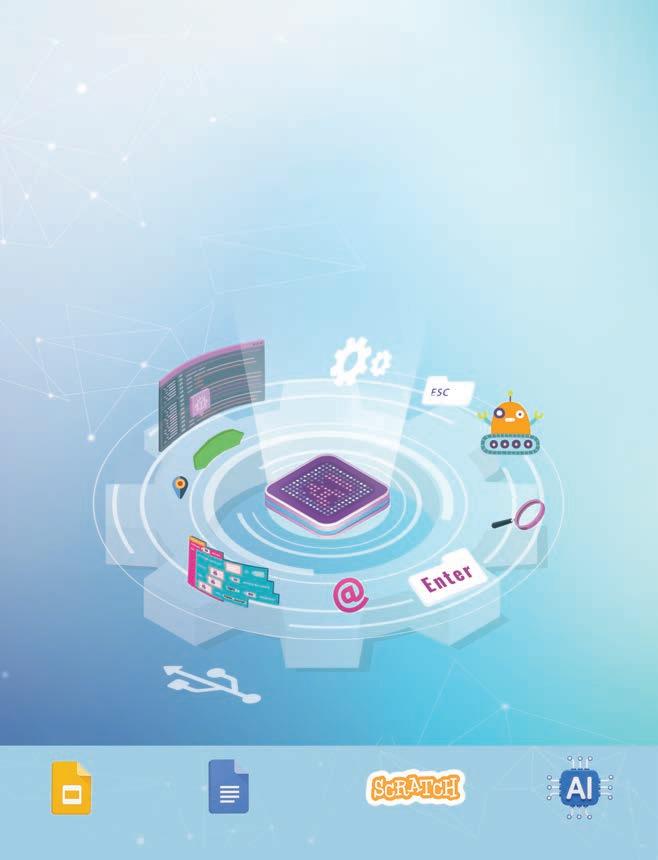





Academic Authors: Jatinder Kaur, Ayushi Jain, Anuj Gupta, Simran Singh
Creative Directors: Bhavna Tripathi, Mangal Singh Rana, Satish
Book Production: Rakesh Kumar Singh, Sakshi Gupta
Project Lead: Jatinder Kaur
VP, Learning: Abhishek Bhatnagar
All products and brand names used in this book are trademarks, registered trademarks or trade names of their respective owners.
© Uolo EdTech Private Limited
First published 2025
This book is sold subject to the condition that it shall not by way of trade or otherwise, be lent, resold, hired out, or otherwise circulated without the publisher’s prior written consent in any form of binding or cover other than that in which it is published and without a similar condition including this condition being imposed on the subsequent purchaser and without limiting the rights under copyright reserved above, no part of this publication may be reproduced, stored in or introduced into a retrieval system, or transmitted in any form or by any means, electronic, mechanical, photocopying, recording or otherwise, without the prior written permission of both the copyright owner and the above-mentioned publisher of this book.
Book Title: Hexa Computer Science 4
ISBN: 978-81-979297-1-7
Published by Uolo EdTech Private Limited
Corporate Office Address:
85, Sector 44, Gurugram, Haryana 122003
CIN: U74999DL2017PTC322986
Illustrations and images: www.shutterstock.com, www.stock.adobe.com and www.freepik.com
All suggested use of the internet should be under adult supervision.
In today’s rapidly evolving digital landscape, computer science has become an essential field of study, shaping the world around us in countless ways. From the smartphones in our pockets to the vast networks that connect people across the globe, computer science drives innovation and progress in nearly every aspect of modern life. In today’s fast-paced digital world, understanding the basics of computer science is as important as learning to read, write, or solve maths problems.
Recognising this imperative, the National Education Policy (NEP) 2020 has strongly recommended the integration of coding skills, computational thinking, critical analysis, and problem-solving abilities into the curriculum.
Inspired by these insights, Uolo has introduced a comprehensive program, Hexa, for grades 1 to 8, to empower young minds with the knowledge and skills they need to thrive in the digital age. From the basics of how computers function to the tools that shape our digital landscape, this series opens the door to a world of endless possibilities. This series will build a strong foundation, helping shape the next generation of digital citizens and innovators. It aims to demystify the world of computer science, making it accessible and engaging for young learners, while preparing them for future academic and professional pursuits in the field.
We believe that learning computer science should be an engaging and accessible experience for all children. This series takes a project-based approach, allowing students to learn by way of concurrently applying acquired knowledge and skills. As they progress through the course, they will build strong foundations in computational thinking, coding basics, and digital literacy. Our program focuses on three key areas:
1. Computer Science Fundamentals: Core concepts are introduced step by step, ensuring a solid grasp of how computers function, and how information is processed and stored.
2. Latest Computer Tools: Various computer tools relevant to today’s world are included, equipping students with the confidence to thrive in the digital age.
3. Introduction to Coding: The series offers an introductory look into coding, preparing students for more advanced learning in the future.
To broaden the learning process, we have included informational annexures on Artificial Intelligence (AI) and its related fields, offering students an early insight into the groundbreaking technologies that are shaping our world. These sections aim to inspire curiosity and encourage a deeper exploration of computer science.
Our mission is to make computer science approachable and exciting for young learners. By providing early exposure, we aim not only to teach about computers but also to cultivate skills that will benefit students in their future endeavours.
We invite you to embark on this exciting journey with us through the world of computer science. Let us empower the next generation with the skills and the knowledge they need to thrive in a digital world.

Art Integration
The National Education Policy (NEP) 2020 outlines essential skills, values, dispositions, and learning approaches necessary for students to thrive in the 21st century. This textbook identifies and incorporates these elements throughout its content, activities, and exercises. Referred to as “NEP Tags”, they are defined as follows: GAMES


INTEGRATED



CRITICAL THINKING

Bringing creativity and fun into learning by combining music, drama, and art with other subjects
Sports Integration
Using games and sports in daily life to enrich computer-related activities
Holistic & Integrated Learning
Cross-curricular linkages to make the learning experience more holistic, joyful and meaningful
Critical Thinking
Coding opportunities to apply higher-order skills like algorithmic and computational thinking, and problem-solving

SDG
Hands-on Activity
Step-by-step activities to enable learners put theoretical knowledge into practice
Sustainable Development Goals
Applied computer science activities related to real-world issues and sustainable development

SEL Social Emotional Learning
Developing the skills to understand and manage emotions, build positive relationships with others and make responsible choices

An Internet Service Provider, or ISP, is a company that provides you access to the internet, often for a fees. Some examples of ISPs are BSNL, Airtel, Jio, and Excitel.
To draw a circle, press and hold down Did You Know?




Communication media helps us connect to the internet. Let us see some of their types.
DSL stands for Digital Subscriber Line. It is a type of communication media that uses your telephone line to transmit data.
Project-based Learning: A project-based learning approach employed to foster an engaging and interactive learning experience




Cable is a type of communication media that uses the existing cable television wires to connect your computer to the internet.
NEP Tags: To show alignment with NEP skills and values
Fibre optic cable is a type of communication media that uses light rays to connect your computer to the internet. Fibre optic cables are much faster than copper or cable wires. In fibre cables, the data travels in the form of light. Nothing in the universe travels faster than light. So, the internet through fibre optic cables is often the fastest type of internet connection available.


Chapter Checkup
Discuss: A multi-faceted probing question, related to the concept, that arouses curiosity


Now think of the fan speed knob, or regulator, on the switchboard. It changes the speed at which the fan spins, instead of just switching it on or off. We can have the fan spin at the fastest speed, reduce it to a slower speed, then much slower, and finally switch it off. We can do more things with the regulator than the switch. That is how analog signal works.
Find out which type of internet connection your house or school has.
3. After selecting it, go to the main drawing area.
e I hold all the blocks for a block category.
A Fill in the blanks.
Did You Know: Interesting facts related to the topic
India has the second-largest internet user base in the world, with over 70 crore users.
3
Think and Tell
Can you think of more examples of analog and digital signals?
Hints menu bar untitled backdrop blocks create
1 In Scratch, we use colourful to create our own games, stories, and drawing.
An Internet Service Provider, or ISP, is a company that provides you access to the internet, often for a fees. Some examples of ISPs are BSNL, Airtel, Jio, and Excitel.
Do It Yourself: Short exercises between the chapter to pause and assess comprehension

2 To create a project in Scratch, you need to click
4. Hold the left mouse button, move the pointer and then release the button. You will see that a triangle has been drawn. In the same way, we can draw many shapes in Paint.
Communication media helps us connect to the internet. Let us see some of their types.
3 By default, the name of the Scratch project is .
1. DSL
Think and Tell: Analysis, reflection, and text-to-self connection based prompts for discussion in class
4 The purple bar at the top of the Scratch editor is called the
DSL stands for Digital Subscriber Line. It is a type of communication media that uses your telephone line to transmit data.
2. Cable
5 The background of the stage is called the .
F Apply your learning.
AI Annexures: To offer a basic understanding of specific domains of Artificial Intelligence
Cable is a type of communication media that uses the existing cable television wires to connect your computer to the internet.
e I hold all the blocks for a block category.
3. Fibre
A Fill in the blanks.

Hints menu bar untitled backdrop blocks create
Chapter Checkup: Chapter-end practice exercises aligned to different levels of Bloom’s Taxonomy
Artificial Intelligence, or AI, helps computers think. It can learn like people do.It learns new things all the time. AI is very smart. It will keep changing and getting
1 In Scratch, we use colourful to create our own games, stories, and drawing.
AI
Apply Your Learning: Intellectually stimulating questions designed for higher order thinking and analysis
Test Papers: Designed to evaluate understanding of core concepts and application of skills
A. Fill in the blanks.
2 To create a project in Scratch, you need to click

1 Nia is making a Scratch project where she needs to move the dog from left to right. Which block should she use?
Fibre optic cable is a type of communication media that uses light rays to connect your computer to the internet. Fibre optic cables are much faster than copper or cable wires. In fibre cables, the data travels in the form of light. Nothing in the universe travels faster than light. So, the internet through fibre optic cables is often the fastest type of internet connection available.
e I hold all the blocks for a block category. A Fill in the blanks.
3 By default, the name of the Scratch project is
4 The purple bar at the top of the Scratch editor is called the
Hints menu bar untitled backdrop blocks create
5 The background of the stage is called the F Apply your learning.
AI can help in schools with learning.
Chapter 4 • Browsing the Internet
1 In Scratch, we use colourful to create our own games, stories, and drawing.

Find out which type of internet connection your house or school has.
1 Nia is making a Scratch project where she needs to move the dog from left to right. Which block should she use? Chapter Checkup
2 To create a project in Scratch, you need to click
3 By default, the name of the Scratch project is
4 The purple bar at the top of the Scratch editor is called the
AI can play games with you.

5 The background of the stage is called the F Apply your learning.
Test Paper (Based on Chapters 1 to 4)
1 Nia is making a Scratch project where she needs to move the dog from left to right. Which block should she use?

1 In Scratch, the blocks you put together in the script area are called a
A. Fill in the blanks.

1 In Scratch, the blocks you put together in the script area are called a
2 The is the background of the stage.
2 The is the background of the stage. Test Paper (Based on Chapters 1 to 4)
•
•
•
• Renaming and Selecting
• Duplicating and Moving Files and Folders
• Shortcut Icons
• Deleting and Restoring Files and Folders
•
•
•
• Introduction to Presentation
• Creating a Presentation
• Components of Google Slides Window
• Working with Google Slides
• Block-based Coding
• Scratch 3.0
• Creating a Project
• Components of Scratch
• Sprites
• Deleting a Sprite
• Ways to Add a Sprite
• Renaming a Sprite
• Ways to Add a Backdrop
• Events Blocks
• Making a Sprite Say Something
• Motion Blocks
• Loops
• Sensing Blocks
• Moving a Sprite
Making a Sprite Fall
•
•


Do you know, we did not always have watches or mobile phones to know the time.
Long ago, people used something called sundials. They used the sun’s shadow to know what time it was.
The Jantar Mantar in Jaipur was built by the king, Sawai Jai Singh II. It is the world’s largest stone sundial! Did You Know?
Later, large clocks were invented.
Then, these clocks got smaller in size. They could be carried around in pockets or worn on one’s wrist.
Nowadays, we have smartwatches that not only tell us the time but also do much more than that, like:
• showing messages,
• letting us use the internet, and
• setting alarms.

This is how clocks have got better and smarter over time. But since ancient times, they have served a common purpose—to track time!
Things around us that perform specific tasks are called devices.
Think and Tell
Name a few devices around you and say how you use them.
If you look closely, we are surrounded by devices. Even a nail is a simple device that helps us hang photographs or a calendar on the wall. A smartphone is a complex device that helps us stay connected with friends and family, send messages, watch videos, and even play games.
Computers are smart devices that can help us do lots of things. We can use the internet on it to find information on many topics.
Computers also let us play games, watch videos, type assignments, and draw pictures on them.
Like clocks, computers have also evolved through the ages. The first computer, developed by Charles Babbage, was bigger than a room. Smartwatches, on the other hand, are actually small computers!
A computer is an electronic device or machine that performs various calculations and carries out different tasks for us, based on the instructions that we give it.

Computers are becoming stronger and tinier. Know more about it here!
But how does the computer do all this? Let’s learn about it in the next section.
A computer takes inputs from us in the form of ‘data’, processes them, and finally provides us with output in the form of ‘information’.
Data is facts, numbers, or symbols that we collect and enter into the computer.
Information is the knowledge or understanding that we gain when the computer analyses and puts together the data that we entered in it.
Let’s understand data and information further with the help of an example.
Imagine you have a jigsaw puzzle with many pieces that together make a picture. Each piece shows only a part of the picture and doesn’t reveal the whole picture on its own.
But when you put all the pieces together and finish the puzzle, you see and understand the full picture!
Similarly, data is like the separate pieces of the puzzle. As pieces, they do not give us complete information. However, when we put them together in the right way, they become the information we need.


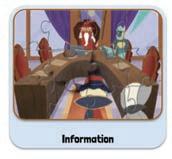
In a nutshell, a computer is a device that accepts input data from us, processes it as per the instructions we provide, and finally produces the result as output or information. So, watching videos, listening to music, and playing games on the computer are all examples of input, processing, and output.
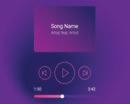

Give one example of data and information.

Computers process data using the Central Processing Unit or CPU. The CPU is like the brain of the computer. It takes our inputs and processes them. After processing the data, the computer gives us the results, or output, on a screen, on paper, or as a sound on the speaker.
Can you think of some more examples of input and output in computers?
With time, devices are getting smaller and faster. It happened with clocks; now, it is happening with computers too!
What does the inside of a computer look like? What does a CPU look like? Scan and find out.

Which of the following is not a device? Tick () the right option.
a Virus b Pen c Hammer d Comb
Write T for True and F for False.
a Clocks have grown in size over the last few hundred years.
b Computers continue to get smaller and faster with time.
c Computers can help us only to watch films.
d Data is like the pieces of a puzzle, while information is like the complete picture.
Imagine that you are scrolling down the computer screen with your mouse. Arrange the steps as a to c in the correct order.
Processing the input
Looking at the movement of the mouse on the screen
Moving the mouse on the table

Akshay loves to write. In fact, he writes in his personal diary every night before he goes to bed. He shares everything with his diary: what went well in the day, what did not; what made him happy, what did not; and what he learnt and what he could have done better. He writes it all down.
Just like the diary stores the details of Akshay’s day, a computer has memory to store data and information. Everything that we do on the computer is stored in its memory, for example, saving a file, storing pictures, and downloading something from the internet.
Computer memory is measured in units called Bytes. Kilobytes (KB), Megabytes (MB), Gigabytes (GB) and Terabytes(TB) are bigger units of computer memory.
1024 Bytes = 1 KB (KiloByte)
1024 KB = 1 MB (MegaByte)
1024 MB = 1 GB (GigaByte)
1024 GB = 1 TB (TeraByte)
Storage with capacities in Gigabytes (GBs) and Terabytes (TBs) are like super-duper backpacks that can hold a LOT of information!
A storage of 1 GB is equivalent to about 20,000 photos or videos as long as 300 hours! A TB is even larger—it is roughly equivalent to 20 lakh photos and 3-lakh hours long videos!
There are two types of computer memories—Primary and Secondary.
Let us understand the two using the example of Akshay and his diary.
Many things happen in Akshay’s life. Akshay remembers things that happened even a few years ago. However, as he grows older, newer things will keep happening in his life. This makes him forget the older things, at times.
So, we can say that Akshay’s mind is his primary memory.
Similarly, in computers, its primary memory holds data related to programs that are currently running in it. It is like the computer’s working area, where it keeps everything that it is actively using.
Primary memory, therefore, is the computer’s internal memory where it stores data related to currently running programs. It is the built-in memory of the computer and is always available to the CPU.
In computers, a type of primary memory exists which is called Random Access Memory or simply RAM.
RAM is that type of the computer’s primary memory that stores information about the programs you are using right now. For example, working on a document, playing a game or listening to music. When the computer is turned off, the RAM is cleared, like a blackboard is wiped clean.


The other type of primary memory is called Read Only Memory or ROM.
ROM is that type of the primary memory that stores important instructions and information that the computer always needs for functioning. It contains rules instructions the computer reads every time it starts, so it knows how to work. But if you switch off the computer, unlike RAM, ROM does not erase its memory.
RAM is like the computer’s short-term memory. When the computer is turned off, data is lost.
It helps the computer work faster and better.
Data on the RAM can be changed or erased.
It is used to store data and instructions that the computer is currently using.
E.g. RAM is used to store the data of the game we are currently playing.
ROM is like the computer’s long-term memory. Data is not lost when the computer is turned off.
It helps to run the computer.
Data on the ROM cannot be changed or erased.
It is used to store important instructions that help the computer perform its basic functions like shutting down and restarting.
E.g. ROM is used to store the information for things like starting and rebooting the computer.
Think and Tell
We learnt that the primary memory, like our mind’s memory, is limited.
But what about Akshay’s diary? After sometime, Akshay could forget older things that had happened, but the diary will continue to store them. The diary is, therefore, an example of what is called the secondary memory.
Secondary memory, also known as auxiliary memory, is the computer’s external storage beyond the primary memory. It is used to store data and programs that are not immediately needed by the computer’s processor.
The memory of your computer can be increased using secondary storage devices. Some examples of secondary storage devices are external hard disks, pen drives (also called flash drives), and SD cards.
Let us learn more about them.
It is the main storage device for a computer. It is made up of disks called platters. It is generally a part of the computer but it can be removed and replaced. We also call it a Hard Drive. HDDs can store data in several Gigabytes (GBs) and even a few Terabytes (TBs).
External Hard Disks can be connected to the computer. They can store data in Gigabytes (GB) or even in Terabytes (TB). They are not fitted inside the CPU and are generally connected to the computer with a wire. An external hard disk is a portable storage device, which means we can carry it with us.
A pen drive is a small and handy device that helps us store and carry important information such as our school projects, pictures, and even music or videos. These tiny devices can store a lot of data, sometimes up to 2 TB! They are also called flash drives. They are also portable like External Hard Disks but are much smaller in size.
A memory card is a small, flat device that is mostly used to extend the memory of devices like a camera or a smartphone. Even though it is very small, it can store a lot of pictures and videos!
Using a memory card is easy. We just need to slide it into the memory card slot of our device. Once it is inside, our device can read the information stored on the memory card. Memory cards typically store data up to a few hundreds of GBs.




These are small and shiny discs that we can put inside a CD or DVD player. We usually use these to listen to music, watch films, and play games. We can also store other important things like files and pictures on CDs and DVDs. CDs typically store data up to a few hundreds of kilobytes (KBs), while DVDs up to a few GBs.
These days, we also have a digital storage space called cloud storage. It is a big storage space on the internet where you can keep all your files and access them anytime, anywhere, and from any device as long as you are connected to the internet. Cloud storage can provide large storage capacity. Most of the time, we get free cloud storage of up to a few GBs.

Don’t you think it is magical to use your files from anywhere and at anytime? Let us learn more about cloud storage here!
3 Do It Yourself 1B
Classify each of the following as primary memory or secondary memory devices.
Which type of primary memory is used for these functions? Write the correct type in the blank beside it.
Computer Functions
a A game is played on the computer
b Managing how a mouse would connect to the computer
c How the computer would restart
d A website is opened on the Google chrome
RAM or ROM
Arrange the following devices in order of their usual storage space, from highest to lowest.
A. Fill in the blanks. Hints
is just simple facts, numbers, or symbols that we collect.
The knowledge or understanding we gain from the processed or organised data is called .
A KiloByte is equivalent to bytes.
The data on a gets lost when the power is switched off. storage of the computer is limited, while storage is unlimited.
B. Tick () the correct option.
Hard disk is also known as:
a Hard drive
b Pen drive
c SD card d Cloud storage
Which memory stores data on the internet?
a RAM b Cloud storage
c Hard disk d Flash drive
The smallest unit of data among the following is: a Byte
TB c KB
How many types of memory are there in a computer?
One
Three
C. Who am I?
GB
People add me when they have limited space on their camera.
I am like loose pieces of knowledge. Putting me together gives you the complete picture.
I am used by the computer for running active programs.
I’m a digital storage space on the internet.




D. Write T for True and F for False.
ROM is the secondary storage device connected to the computer.
Secondary memory is also called internal memory.
Things stored on cloud storage can be accessed from anywhere.
If my computer is running slowly, it could be because I am running too many programs and taking up too much RAM.
E. Answer the following questions.
Do you think a computer is a device? Explain your answer.
How many types of computer memory are there? Explain them, briefly.
What is secondary memory? Give three examples of secondary memory.
What is cloud storage? Write two advantages of cloud storage.
What are the differences between data and information? Mention any two.
F. Apply your learning.
Arnav is a Grade 4 student who loves drawing on his tablet. He has made many amazing drawings, but he is worried about losing them if something happens to his tablet. Which storage should Arnav use to save his digital art?
Nisha is an engineer. She works on multiple programs on her computer for long hours. She often struggles with her computer as it keeps hanging every now and then. She finally decides to buy a new computer. What are some of the things she should keep in mind when buying a new computer?
Hint: Think about primary and secondary memory!




While working on his project, Rahul was working on a document. After a while, he decided to take a lunch break. While he was eating lunch, there was a power cut and the computer switched off immediately. Would Rahul find his document exactly as he left it when he turns his computer on again? Explain your answer.
We can do a lot of things on computers—play music, watch videos, and play games.
But do you know what makes all these things possible? The Operating System (OS). The OS makes the computer run smoothly and do multiple things in it.
But what is an Operating System (OS)?
An operating system is a software that helps us to communicate with the computer and tell it what to do.
Software is a set of instructions that tells a computer what to do.
Did You Know?
The first operating system was called “GM-NAA/O” and was released in the 1950s.
The OS is like the principal of a school. Just like the principal runs the school, the OS runs a computer.
There are many types of operating systems, as shown below:
Let us look at some of the features of an operating system.
• Easy-to-use interface: An interface is a medium to talk to a machine. The OS is an interface that lets you talk to your computer. You can use icons, buttons, and menus to tell the computer what you want it to do.
• File management: The OS helps you to organise files and folders in a proper way. It also helps you to find your files easily when you need them.
• Multitasking: The OS lets you work on multiple tasks at the same time. You can easily switch between different apps and programs without any confusion. For example, you can paint a picture and play a song on your computer at the same time.
• Memory management: The OS keeps track of how much memory each program is using and makes sure that no program uses too much memory.
• Device management: The OS manages all the devices connected to your computer and makes sure they are ready for use when needed. For example, if you want to print a document, the operating system makes sure that the printer is connected to your computer and that it is ready to print.
Windows 10 is one of the most popular operating systems for computers. It has many features and functions.
To start a computer that has Windows 10, do the following:
1. Press the power button to turn on your computer.
2. The computer then starts getting the system ready for you to use it. This process is called Booting. The program which helps in booting is known as the Basic Input Output System (BIOS) program.
3. Once Windows 10 is loaded, you will see the Windows 10 desktop. Let us learn the different elements of the Windows 10 desktop.
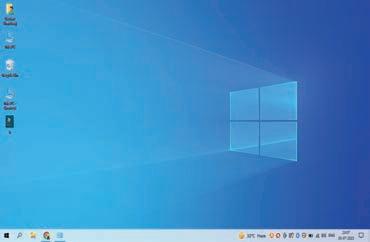

Windows lets you unlock your computer using your face, fingerprint, or an eye scan to make it more secure. Did You
Description
Desktop It is the main screen on the computer when it is ready to use.
Taskbar This is a bar at the bottom of the screen on the desktop.
Start button It opens the Start Menu on clicking. The Start Menu shows the list of all the apps installed on your computer.
Icons
These are shortcuts of files and folders on the desktop that we can quickly access.
Wallpaper The wallpaper is the background image on your desktop.
Which icons do you think we should have on our desktop?
Which of the following are the elements of the desktop? Tick () the correct option.
a We can paint on a computer even without an operating system.
b The computer boots when it is switched on.
c We can have many icons on the desktop.
Desktop Process of starting the computer
Booting
Bar at the bottom of the desktop window
Taskbar Area where you see icons and wallpapers
We have many things in our room—clothes, notebooks, toys, and so on.
But we place our most important things on the tabletop, things that we use most frequently. Similarly, we put our most important apps, files, and folders on the desktop. Let’s learn more about the elements of the desktop.
The Taskbar is the bar in the bottom of the desktop. You can put your favourite apps on the taskbar so you can find them easily. This is really helpful when you use the same apps many times, like a web browser or a game.

• Start button: The Start button is like the gateway to your computer. By clicking on it, you can access your programs, settings, and files.
• Search button: The Search button is a handy tool next to the Start button. It allows you to search for files, programs, settings, and even search the internet.
• Dock: The dock is an area on the taskbar where you can put shortcuts to your favourite apps for easy access. It is like a quick menu for opening your most-used programs with just one click.
• Notification area: The notification area, or the system tray, is a small part on the right side of the taskbar. It shows icons for programs and notifications. It tells you important things, like new emails or updates.
• Desktop show/hide button: The desktop show/hide button is a button on the taskbar. It helps you quickly minimise or hide all open windows and show your desktop with just a click.
Is the functionality of the desktop show/hide button and Aero Peek feature the same?
Aero Peek is a feature in Windows that lets you see your desktop without actually minimising any of your open windows. To use Aero Peek, you just need to hover your mouse over open applications in the taskbar. Hover means letting your cursor float over an icon without clicking it.
The next time you are using a computer, why don’t you try and hover over all the taskbar features to see what they do?
The taskbar location can be changed on the screen. It can be placed on the left, right, top, or bottom of the screen.
Let us see how we can change the location of the taskbar:
1. Move the mouse pointer to the taskbar and right-click on it.
2. Choose the Taskbar settings option from the pop-up menu.
3. The Settings window opens up for the taskbar features. Scroll down to the option ‘Taskbar location on screen’.
Choose the Taskbar settings
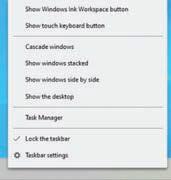
4. Select where you would like your taskbar to be. The taskbar will automatically move to the new position you selected.


Select the location from the drop-down




Imagine you are working on a school project. You need to switch between a document and a web browser. How will you do that?
You can click on their icons in the taskbar at the bottom of your screen. It is like changing channels on your TV. But do you know that we can switch between the two things in even faster ways by using Shortcut keys?
The Windows key is a special key at the bottom-left of the keyboard. It is used in combination with other keys to make Shortcut keys. Let us learn about a few shortcut keys and their function.
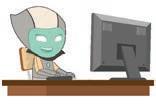
Windows
Windows
Windows
Windows
Windows
Opens the Task View, where you can switch between open windows and virtual desktops.
Windows
Windows
Windows
Opens the Search feature to find files, applications, settings, or even search the web.
Open the Settings menu, where you can customise various options related to your computer.
Minimises all open windows and takes you directly to the desktop.
Search for the following words in the given Word Search grid.
Words: WINDOWS 10
Let us learn to apply various settings such as theme colour, font, background, screen saver, mouse pointer, date and time, and volume on the computer desktop, one by one.
Steps to customise the colours on your computer:
1. Click the Start button and select the Settings menu.
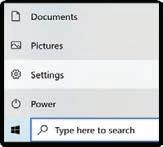
Select Settings from Start Menu
Did You Know?
In the 1950s, the first computer operating system, called “General Motors Research Operating System,” was developed to control and manage early computers.
2. The Windows Settings opens. Choose the Personalization option from the menu.
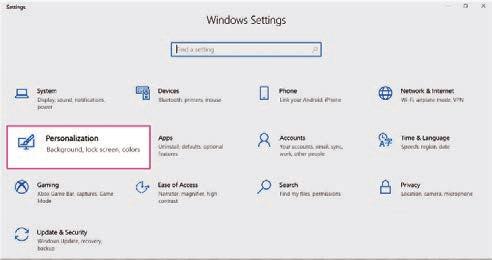
3. Select Colors option from the sidebar.
4. Choose a colour of your choice from the Windows colors palette.
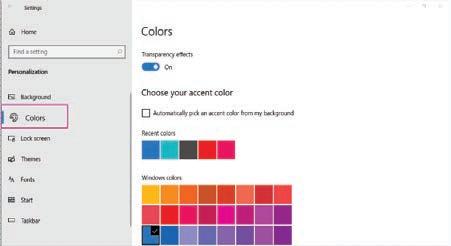
Select Colors option
Choose a color
5. The changes will take effect right away.
Steps to adjust fonts on your computer:
1. Open Settings and select Personalization option.
2. Select Fonts option.
3. Select the font style and size you want.
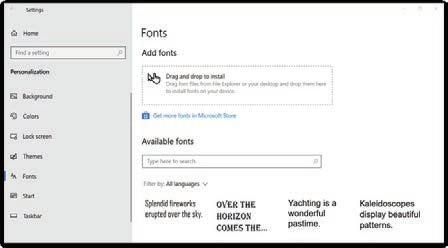
Choose a font
Select Fonts option
4. Preview the font as you make the changes.
5. The font settings will be applied automatically.
Steps to set date and time:
1. Open Settings from the Start button.
2. Select the Time & Language option.

Select Settings from Start
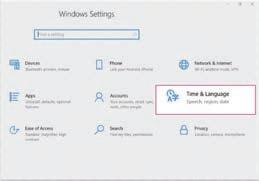
Select Time & Language
3. Select Date & Time option.
4. Toggle the switch to turn on the automatic time settings. Toggle means switching between two options by pressing or clicking. Here the options are on and off.

Select Date & Time
Toggle the switch to turn on the automatic time
Windows 11 is the latest version of the Windows operating system from Microsoft. It is the software that runs on your computer, letting you use apps, browse the internet, and do many other tasks.
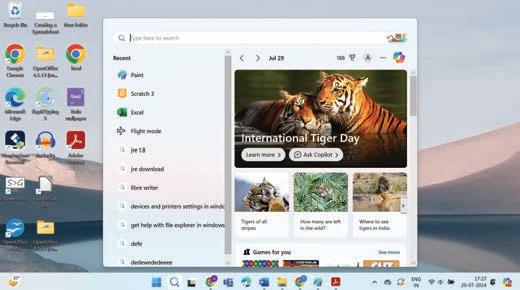
The Taskbar is the bar at the bottom of the window. This shows the Start button, app icons, and the system tray (where you find things like the clock and battery status). The Start button is in the center, making it easy to access.
The Copilot feature in Windows 11 is a new AI-powered tool integrated into the operating system. Copilot uses smart technology to make your computer easier to use. The Copilot feature may appear as an icon representing the AI or as a button labelled “Copilot” on the taskbar itself or can be accessed through the taskbar using Search option.
1. AI Assistance: Copilot uses artificial intelligence to provide smart suggestions, answer questions, and assist with various tasks directly within the Windows 11 environment.
2. Context-aware: It understands the context of what you are doing and offers relevant help, whether you are drafting an email, working on a document, or managing files.
3. Integration with Apps: Copilot can interact with Microsoft Office apps and other third-party applications, helping streamline tasks and improve productivity.
4. Personalised Recommendations: It learns from your usage patterns to offer personalised tips and shortcuts tailored to your preferences and needs.
5. Voice and Text Input: You can communicate with Copilot using both voice and text, making it versatile for different user preferences.
6. Enhanced Search Capabilities: It helps improve search results by understanding the intent behind your queries, offering more accurate and relevant information.
7. Built-In Privacy Controls: You can manage and customise Copilot’s behaviour and access to ensure your privacy and data security.
In Windows 11, there are shortcuts that help us complete tasks effectively.

+ M Minimise all open windows.
Description

+ Up ArrowMaximise the current window

+ Down ArrowMinimise or restore the current window

+ Left ArrowSnap the current window to the left half of the screen

+ Right ArrowSnap the current window to the right half of the screen

+ Z Open the Snap Layouts menu for arranging multiple windows

+ H Opens the Dictation tool, letting you type text using voice input

+ S Opens the Search bar
A. Fill in the blanks.
Hints desktop operating system notification booting aero peek
Windows 10 is an example of an .
When you turn on a computer, it goes through a process known as . The is the main screen of your computer where you can place shortcuts, files, and folders. is a quick preview of the desktop.
The area on the taskbar displays notifications and system icons.
B. Tick () the correct option.
c Taskbar d Desktop 1 2 3 4
shortcut key minimises all open windows and takes you directly to the desktop.
a Windows key + C b Windows key + S
c Windows key + I d Windows key + D
What does memory management in an operating system do?
a Tracks memory usage b Manages files
c Controls devices d Manages icons
The search feature in Windows 10 that helps you find files, settings, and applications is called the .
a Start Button b Search Bar
c Quick Access d Notification Area are shortcuts of files and folders on the desktop that we can quickly access.
a Icons b Wallpaper
C. Who am I?
I help you make your device work smoothly, and control all the apps and games you love to use. Without me, your device wouldn’t know what to do.
I am the screen where you can do lots of things on your computer. You can click on icons to open programs and change settings.
I am a small picture or symbol that represents a program, file, or folder on your desktop. You can click on me to open or access what I represent.
I am a special area on your computer screen where you can see and switch between open programs or apps. You can find me at the bottom of the screen.
D. Write T for True and F for False.
We boot the computer to shut it down.
The date and time set in the computer can never be changed.
The taskbar in Windows 10 includes features like the Start button and the Notification Area.
Aero Peek lets you see your desktop without minimising any windows.
E. Answer the following questions.
What is an operating system?
Write any two features of the Windows 10 operating system.
How would you define the process of booting a computer?
What is the purpose of Search button?
Anika wants to customise the colour and font settings of her Windows 10 interface. How would she customise the settings?
Shrishti wants to paint a picture and listen to music on her computer at the same time. How can she use the operating system to do this?
Urmi wants to quickly open her favourite apps on her computer. Where can she put shortcuts on the taskbar to make this easier?
John is an American and is traveling to India for work. There is a time difference of about 11 hours and 30 minutes. What should be the changes that he can make in his computer so that he can work better here?

Human beings have always valued writing down memories and experiences. Ancient civilisations recorded their stories, beliefs, and experiences in cave paintings, on clay tablets, and stone inscriptions.


As civilisation advanced, so did the method of recording. It led to the development of writing systems and eventually, the invention of paper and printing.
In modern times, we store important information on our computers for easy access.
But where is this information stored on our computers?
All this information is stored in files on a computer system.
A file is a digital space used to store different types of information on a computer. It acts like a container for items like images, videos, texts and so on.
When we are at school, we take notes in our notebooks. Can we compare a computer file with a notebook?
Files store information for us.
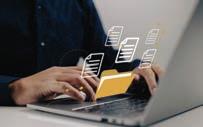
But at times, we might need to organise files. You may, for instance, need to put all school-related files together in one place and other files in a different place. Folders help us do that.

We can also create a folder within another folder. A folder within a folder is called a sub-folder.
A folder is a container that stores files and other folders. Folders can be used to organise files and make them easier to find. They act as holders where you can group similar files together.
We can create different types of files. Let us learn how to create a Microsoft Word file.
Steps to create a Word file:
1. Right-click on an empty space on the desktop. A pop-up menu will appear.
2. Place the cursor over the New option.
3. Click on the Microsoft Word Document option.
4. A new Word Document will be created with a default name, New Microsoft Word Document.
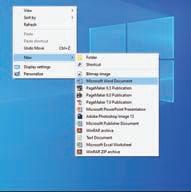
Steps to create a folder:
1. Right-click on an empty space on the desktop. A pop-up menu will appear.
2. Place the cursor over the New option.
3. Click on the Folder option.
4. A new folder will be created with a default name—New folder.
5. To create a folder quickly, press the Ctrl+Shift+N keys together.

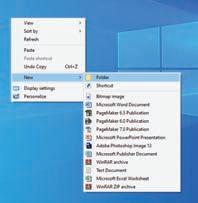
Steps to create a subfolder:
1. Open the main folder by double-clicking on the icon.
2. Right-click inside the main folder. Follow the same steps as earlier to create the folder easily. A new folder within this folder will now be created.

Position the cursor over the New option.
Click on the Folder option.
We learnt how to create files and folders. New files and folders are assigned default names once created.
Let us learn how to rename them according to our preferences. Renaming a folder/file means changing the name of our digital files and folders.
Steps to rename a folder:
1. Right-click on the folder. A pop-up menu will appear.
2. Select Rename option. This will let us change the name of the folder.
3. Type in a new name.
4. Press Enter key or click outside the folder to save the new name.
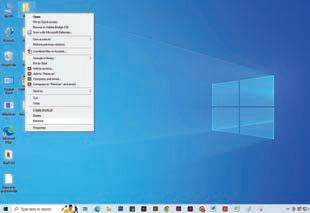
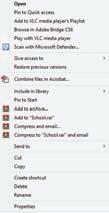
Select the Rename option.
Steps to rename a file:
1. Right click on the file, a pop-up menu will appear. Select the Rename option.
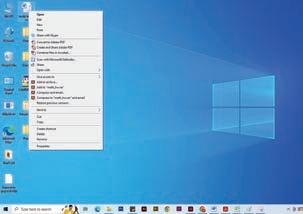

2. Select the Rename option. This will let us change the name of the file.
3. Type in the new name for the file.
4. Press Enter key or click outside the file to save the new name.
Why do you think it is important to give correct names to folders?
Number the following steps a to d to create a folder in the correct order.
Give it a name.
Position the cursor over the New option.
Click on the Folder option.
Right-click on the desktop.
To do any operation on a file or folder, we first need to select it. Let us learn about this.
Steps to select a single file or folder:
1. Click on the file or folder you want to select.
2. The file will be selected.

Steps to select multiple files or folders:
Click on the file or folder to select it.
1. Press and hold the Ctrl key and select the files by left clicking on them one by one.

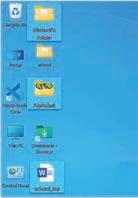
2. All the files will be selected.
Steps to select a range of adjacent files or folders:
1. Press and hold the Shift key.
2. Click on the first file or folder in the range.
Click on the files or folders one by one to select.

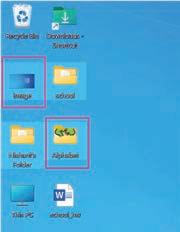
Let us say we are preparing for a play for the Annual Day at school. We have one copy of the script, but there are nine students acting in the play. We need to make copies of the script so that everyone can have their own copy. What can we do?
Click on the first file or folder in the range.
Click on the last file or folder in the range.

We can go to the nearest photocopy shop. The shopkeeper creates an exact copy of our document by pressing the Copy button on a photocopy machine. Once the copying process is complete, he takes the freshly copied document and gives it to us.
Similarly, on a computer, you can copy files and folders and paste them in different locations. The main document that you copied remains at the same location without any changes.
Hence, duplicating files and folders means making an exact copy of a file or folder and pasting the copied file or folder into a different location of our choice. You can copy and paste the copied file or folder to the same location also, it will be saved with the similar name with Copy word as suffix.
Steps to copy and paste a file in a folder:
1. Right-click on the file or folder you want to copy. A pop-up menu will appear.
2. Click on the Copy option.


3. Open the folder you want to paste it in.
4. Right-click on the empty space in the desired folder. Then, select the Paste option.
5. The copy of the file or folder is now in the new location.
6. You can also use Ctrl+C to copy and Ctrl+V to paste.
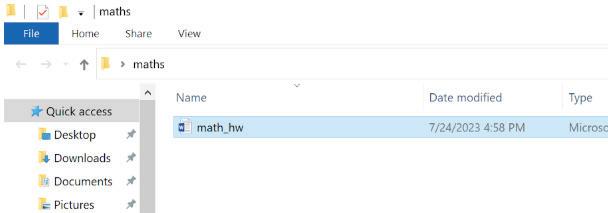
To make our books easy to find, we organise our bookshelves. Similarly, to tidy up our computer drive, we can move a file or folder to a different place. When we want to move a folder or file on a computer, we can use special commands called Cut and Paste.

First, we select the folder or file we want to move, just like a person picking up a stack of documents. Then, we Cut the folder or file, which is like lifting the stack of documents off a table.
Finally, we Paste the folder or file in the new location. The computer moves the whole folder/file there, just like a person sets down a stack of documents in a new spot.
Steps to move a folder or file:
1. Right-click on the folder or file. A pop up menu will appear.
2. Click on the Cut option.
3. Open the folder you want to paste it in.
4. Right-click on an empty space where you want to move the folder or file and then select Paste.
5. The file will be moved to the new location.
6. You can also use Ctrl+X to cut and Ctrl+V to paste.
In our notebooks, we sometimes use bookmarks to go to important pages. Bookmarks are thin strips of paper that can be attached to a page, as shown in the picture.
Similarly, a shortcut icon helps us quickly open a file or folder. Shortcut icons are usually kept on the desktop to open the most frequently used items.
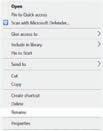


How is moving files and folders different from duplicating them?
1. Locate the file or folder.
2. Right-click on the file or folder you want to create a shortcut for. Then select Create Shortcut option.
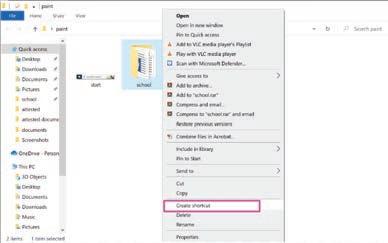
Select the Create shortcut option.
3. A shortcut to the file or folder will be created. The shortcut will have the same name as the file or folder, but it will have a small arrow in the bottom left-hand corner to indicate that it is a shortcut.
4. You can move the shortcut to any location. Usually, shortcuts are placed on the desktop for easy access. Fill in the blanks.
Do It Yourself 3B
1 We can click on a file or folder that we want to select.
2 We can hold the key and then select multiple files together using the mouse.
3 The key allows us to select a range of files.
4 Duplicating a files mean creating a of the file. This does not delete the original file.
5 Moving a file from one folder to another requires us to the file and then paste it to the other folder.
In order to keep our home organised and clean, we keep throwing away things that we do not use anymore.
In the same way, we delete old files that are not needed anymore. Hence, deleting a folder or file means removing it from our computer.
Steps to delete a file or folder:
1. Right-click on the file or folder you want to delete. A pop-up menu will appear.
2. Select the Delete option. The selected file or folder will be deleted.
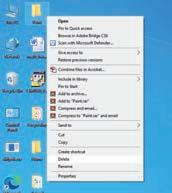
Let’s say you accidentally deleted an important file. What can you do now?
You can restore the deleted folder or file. Restoring means to bring something back.
Removing a folder or file does not completely deletes it from the computer. It is sent to a location known as the Recycle Bin.














Hence, restoring a folder or file means getting it back to the previous location from the Recycle Bin.
Steps to restore a file or folder:
1. Open the Recycle Bin on your computer.
Open Recycle Bin

Did You Know?
If we use the Shift + Delete on a file/folder, we can permanently delete it from our computer. But we must be very careful when using this combination, as those files can never be restored again.
2. Right-click on the file or folder you want to restore. A pop-up menu will appear.
3. Select the Restore option.
4. The folder will be returned to its original location.


Just like we practise good manners in our everyday life, we must also follow a few good practices when using a computer. Let us see what these are:
1. Always name and store your files and folders properly. This helps to keep the computer organised. This is especially important when many people share one computer.
2. Organise the files in labelled folders. This will help you locate a file quickly.
3. Be respectful of others’ files. Do not delete or change the files that belong to someone else without their permission.
4. Do not copy someone else’s file.
5. Do not share files that contain important information with anyone else.
Write T for True and F for False.

1 We can delete a file by right clicking on it and then selecting Delete.
2 A deleted file can be recovered from the Recycle Bin. 3 A file recovered from the Recycle Bin will be sent to a random folder.
We should store all our files in any folder, including folders that do not belong to us.
Restoring a folder or file means getting them back from the A file is a collection of stored on a computer.
To select multiple files or folders, press and hold the key while clicking on the items.
B. Tick (
) the correct option.
Double-clicking on the icon of a file or folder .
a Opens it
c Deletes it
Folders on the computer desktop help to .
a Store information like text, images, and numbers
c Organise festival stuff
Files are .
a Digital containers of information
c Special locations for folders
A subfolder is a
a Folder inside another folder
c Folder which holds other folders
C. Who am I?
I help to keep files organised.
I can hold information like words, pictures, and numbers.
I am where you can find deleted items before they disappear forever.
I can move a file from one place to another.
D. Write T for True and F for False.
Computers use digital files and folders for organisation.
b Renames it
d Selects it
b Group similar files together
d All of these
b Digital documents only
d Containers which only hold letters
b File inside another folder
d Folder which cannot be renamed
Files on a computer cannot contain information like images or sound.
The ‘Cut and Paste’ command is used to move folders or files to new locations.
Files are removed from their original position when copied and pasted to another location.

E. Answer the following questions.
Explain what files and folders are.
What is the difference between moving and duplicating a file?
Why are shortcut icons important?
F. Apply your learning.
Avni shares her computer with her brother, Nishant. Nishant has created a new folder. Avni wants to explore this folder. Should she explore it without asking Nishant first? Explain why.
Raj had drawn a beautiful picture of a cat on his computer. But this morning, while using the computer, he deleted it by mistake. How can he get that picture back?
Tanya has completed her maths homework and stored it in the ‘History’ folder instead of the ‘Maths’ folder. Is this a wise thing to do? Why/Why not?
Satish wants to create a new folder on the desktop to keep his drawings. What are the steps to create a new folder?
The term internet stands for “Interconnected Network”.
A network is a group of computers connected to each other.
The internet is a network of networks that connects computers and devices from all over the world. It allows people to share and collect information, and communicate with each other.
The internet began in the 1960s when scientists wanted a way to share information quickly. Over the years, it has grown and changed a lot. Today, the internet is an important part of our daily lives, helping us stay connected and find information easily.
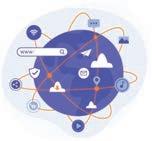
The internet has changed over time. Find out more about it here!

We need a computer and an internet connection to start exploring the internet. To set up an internet connection, we need the following:
Modem stands for Modulator-Demodulator. It is a device that helps your computer connect to the internet. A modem converts digital signals into analog signals, and also analog signals into digital signals. But what are analog and digital signals? Let us find out.
Think of a switch on the switchboard of your house. You can do only two things with the switch—turn it on or turn it off. That is what a digital signal is. The signal either comes in or does not come in.

Now think of the fan speed knob, or regulator, on the switchboard. It changes the speed at which the fan spins, instead of just switching it on or off. We can have the fan spin at the fastest speed, reduce it to a slower speed, then much slower, and finally switch it off. We can do more things with the regulator than the switch. That is how analog signal works.
India has the second-largest internet user base in the world, with over 70 crore users.
Can you think of more examples of analog and digital signals?
An Internet Service Provider, or ISP, is a company that provides you access to the internet, often for a fees. Some examples of ISPs are BSNL, Airtel, Jio, and Excitel.

Communication media helps us connect to the internet. Let us see some of their types.
DSL stands for Digital Subscriber Line. It is a type of communication media that uses your telephone line to transmit data.
Cable is a type of communication media that uses the existing cable television wires to connect your computer to the internet.
Fibre optic cable is a type of communication media that uses light rays to connect your computer to the internet. Fibre optic cables are much faster than copper or cable wires. In fibre cables, the data travels in the form of light. Nothing in the universe travels faster than light. So, the internet through fibre optic cables is often the fastest type of internet connection available.



Discuss!
Find out which type of internet connection your house or school has.
Find and mark the words in the Word Puzzle box.
Words: ISP
Before using the intenet, we need to understand some basic terminologies related to it. Let us learn about them.
A web page is a digital document on the internet. It can have text, images, videos, and other content.
A website is a collection of web pages that are all related to each other.
The WWW, or World Wide Web, is a huge source of information that can be accessed from anywhere in the world. It is a collection of websites with pages of information on the internet. You can use it to learn new things, stay connected with friends and family, and entertain yourself.
A web browser is a program that lets you see websites on the internet. To see a website, you need to type the website’s address into a web browser and press Enter. Examples of web browsers are Google Chrome, Microsoft Edge, Safari, Firefox, Opera, etc.











We can use a web browser to perform the following tasks:
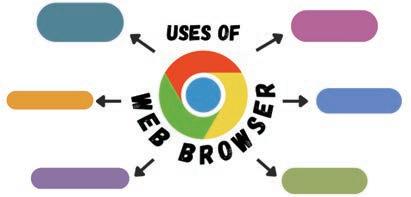
Google Chrome is a web browser provided by Google. It is one of the most popular browsers in the world. It is fast and easy to use, and it has a lot of features, such as the ability to sync your bookmarks and browsing history across devices.
Steps to open Google Chrome:
1. Click on Start.
2. Search for “Google Chrome”.
3. Click on the app icon to open it. When the Chrome web page opens, you will see that it has many parts. Here are the most important ones:
1. Address bar: This is where you type in the address of a website.
2. Back and forward buttons: These buttons allow you to go back or forward to the previous or the next page.
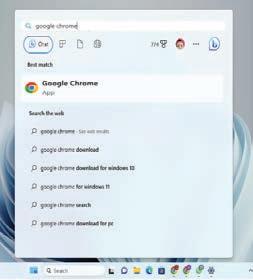
3. Refresh button: This button reloads the page if it is not loading properly.
4. Tabs: Tabs allow us to open multiple websites at the same time.

Other than the main options, we can find some additional options in Google Chrome. We can find these options if we click on the triple dot button in the top right-hand corner of the browser.
• Print: This option allows you to print the current webpage.
• Zoom: This option allows you to zoom in or out of the current webpage.
• History: This option allows you to see a list of all the websites you have visited recently.
Search engines help you find information on the internet. The internet has billions of websites. So you can find almost anything instantly.
Some examples of search engines are:

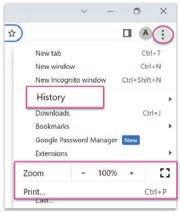

• is the most popular search engine in the world. It has a vast database of websites and can help you find almost anything you’re looking for.

• is the second most popular search engine in the world. It is owned by Microsoft and is often used as the default search engine on Windows computers.

• is a search engine that was created in 1994. It is one of the world’s oldest and most popular search engines.
Imagine you are going to your friend’s house for the first time. Your friend tells you his house address, which helps you find your friend’s house.

Similarly, when we want to open a website, we need a Uniform Resource Locator, or URL. It is a website’s address. It tells your computer where the website is located on the internet. URL is a unique address that identifies a website on the internet.
Net surfing is visiting websites, watching videos, listening to music, and doing other things online.
To surf the net, you need a computer or a mobile device with an internet connection and a web browser. It is a way to find new things to learn about. What does the term ‘www’ stand for?
Do It Yourself 4B






A. Fill in the blanks.
The internet is a big network of all over the world.
The internet through cables is often the fastest type of internet connection available.
A web browser is a program that lets you see on the internet.
Search engines help you find on the internet.
URL is short for .
B. Tick () the correct option.
What is the internet?
a A big library of information
c A place to find new things to learn about
What is a web browser?
a A program that lets you see websites on the internet
c A collection of web pages
What is net surfing?
a Browsing the internet to visit various websites
c Typing a document
b A way to connect computers all over the world
d All of these
b A device used to connect to the internet
d None of these
b Connecting to a modem
d None of these
What is the purpose of a Uniform Resource Locator (URL)?
a To access websites on the internet
c To connect devices to the computer
C. Who am I?
b To connect to the internet service provider (ISP)
d To translate websites into other languages
I am the address of a website that you type into the address bar of your web browser.
I help you find information on the internet by showing you a list of websites related to your search.
I am a program that lets you see websites on the internet.
I am responsible for connecting your computer to the internet. I use your telephone lines to connect you to the internet.
D. Write T for True and F for False.
The internet is like a big library that contains information and data.
The internet started in the 1960s as a way for scientists to share information.
A digital signal has only two states, on and off.
An internet connection doesn’t require a modem or an internet service provider (ISP).
DSL is a type of internet connection that uses a telephone line to transmit data.
E. Answer the following questions.
How can Riya use the internet to send a birthday greeting to her friend who lives in a different city? What does she need?
Abeer lives in a remote village where no modern cables are available. Which type of internet connection can he look for?
Rohan is confused about the difference between a web page and a website. Can you help him?
Lovey wants to search for some information on the internet using a search engine. Can you suggest the names of some popular search engines that she can use?

Suppose you have got an assignment to write a paragraph about hockey. You write the following:
Hockey is one of the most popular games. It requires teamwork, speed, and skill. The hockey players wear protective gear like helmets and pads to stay safe. Many people in our country and around the world enjoy watching and playing hockey.
Now, to write your paragraph on a computer, you will need a word processor.
A word processor is software used to type and edit text.
There are many word processors. Microsoft Word and Google Docs are the two of the most popular ones.
Google Docs is a free online word processor. It is easy to use and lets you work together with friends. It has some interesting features, like:
• getting to see all the changes that your friends make online; and
• opening the document without losing your text as it gets saved automatically online. Let us learn more about it!
To begin using Google Docs, we first need to learn how to make a new Google document.
Follow these steps to create a Google document:
1. Go to the Google Docs website: https://docs.google.com
2. To choose Blank document, click on the plus (+) button.
3. A new document will open.

The main components of a Google document are:
Document Title
This is where the name of your document will appear.
Toolbar
This section gives you quick access to some tools.
Working Area
This is the space where you can type and edit text.
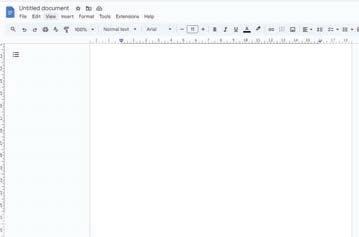
Menu Bar
This bar has tabs with various features.
We have created a Google document. Let us type the information we learnt about hockey.

Google Docs has a feature called autosave. This means it saves your work by itself, so you don’t have to save it manually.
Now that we have added our text, do you think we should make it look more organised and easier to read? Yes, let us do it by formatting the text. But what is formatting?
Formatting text refers to the process of changing the appearance and layout of a written document or piece of text. This makes it more visually appealing, organised, and easier to read and understand.
Here are some ways in which we can format our text:
1. Font: This tool changes the style of the letters in our selected text. You can change the font of your text by doing this:
a. Select the text.
b. Click on the Font option. It will open a drop-down menu.
c. Select the type of font you would like from the drop-down menu.
Your selected text will look like what is shown in the image.

2. Bold: This tool makes the selected parts of the text look thicker and darker. You can make your texts bold by doing this:
a. Selecting the text.
b. Clicking on the B icon on the toolbar.
Your selected text will look like as shown in the image.

3. Italic: This tool makes the selected parts of the text look thinner and leaning towards the right side. You can make your texts italic by doing this:
a. Selecting the text.
b. Clicking on the I icon on the toolbar.
Your selected text will look like it does in the image.
Would you ever make the title of your paragraph bold? Why or why not? Think and Tell

4. Text color: This tool helps you to change the colour of the selected text. You can change the colour of your texts by doing this:
a. Select the text.
b. Click on the icon on the toolbar.

c. Select the new colour for your text from the drop-down colour grid.
Your selected text will change into the colour you have chosen in the grid.


What if we want to apply the same formatting to all the texts in the document? We could repeat the steps, one by one, all over again. Or, we format it in a quicker way. The Paint Format tool helps us copy the formatting from one piece of text and apply it to another text.
Follow the steps to use the Paint format tool:
1. Select the formatted text or place the cursor in between the formatted text.
2. Click on the Paint format tool. Try to notice how your cursor changes to show the Paint format icon.

3. Drag the cursor over the text to which you want to apply the formatting.

4. Leave the cursor and the formatting will be applied.


Google Docs is one of the most popular web-based word processors in the world, with over 100 crore active users. Know more about it here!
Superscripts and subscripts are commonly used in science and mathematics texts. Let us learn the difference between superscripts and subscripts.
Superscript is a formatting style where the text or number is made smaller and raised above the regular text line.
For example, the “2” in a2 is a superscript. Let us type it in Google Docs.
1. Type a2 and select the “2” that you want as a superscript.
2. Click on the Format menu and select Text.
3. Within the Text sub-menu, click on Superscript.

4. The number will appear as superscript a2.
Subscript is a formatting style where the text or number is made smaller and lowered below the regular text line.
For example, the “2” in H₂O is a subscript. Let us try to write the sentence, “The chemical formula of water is H2O.” with 2 in subscript.
Steps to add subscript:
1. Select the text that you want to make subscript.
2. Click on the Format menu and select Text.
3. Within the Text sub-menu, select Subscript.
So, your sentence would now look like this: “The chemical formula of water is H2O.”
Fill in the blanks.
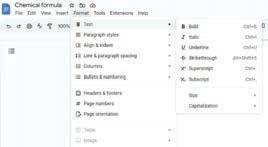
1 is a free online word processor.
2 A text that is looks thicker than normal text.
3 With the tool we can apply a text format to the whole of the text.
4 The format makes the text smaller and raised, while the format makes the text smaller and lowered.
The header is the text that appears at the top of every page in a document. The footer is the text that appears at the bottom of every page in a document.
Steps to add a header or footer:
1. Click on the Insert menu.
2. Go to Headers & footers.
3. Select the Header or Footer option.
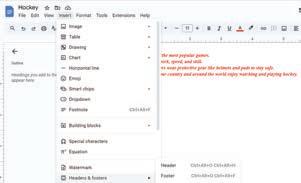
4. Type the texts that you want as the header and footer on every page. Once you have entered them, they will appear as headers and footers on every page.
A page break is an instruction to the computer that tells it where to start a new page, when writing or printing.
Steps to insert a page break:
1. Click where you want the page break to appear.
2. Click on the Insert menu and select Break.
3. Select the Page break.
4. A page break will be inserted at the current cursor location within the document.
What information can you include in headers and footers?
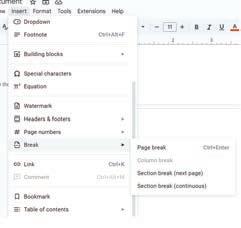
Just as page break is an instruction to start a new page, line break is an instruction to start a new line.
Steps to insert a line break:
1. Click where you want the line break to appear.
2. Press Enter.
Have you ever noticed how a newspaper is set up? Newspapers use a column format. Some of the benefits of using a column format are:
1. Easy reading: Columns break up text into smaller sections, making it easier to read.
2. Organised look: Information is neatly divided, making the page look tidy.

3. Space saving: Paper is precious. More text can fit into a page if we have columns.
Steps to use the column format in your document:
1. Open the document that you want to set in column format.
2. Click on the Format menu and select Columns.
3. Select the number of columns that you want to insert.
4. The text will appear in number of columns you have selected.
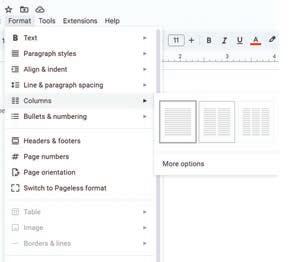
Page orientation refers to the direction in which a document is displayed.
A page can be displayed horizontally or vertically. A horizontal page orientation is known as Landscape and the vertical page orientation is called Portrait.
Steps to change page orientation:
1. Click on File and then select Page setup
2. In the Page setup dialog box, in the Orientation section, select the Portrait or Landscape option.
3. Click on OK to save the changes. Your page orientation will change, as shown in the image.

A. Fill in the blanks.
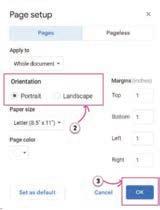
To start a new document, you need to click on the button. lowers text or numbers below the regular line.
The header is the text that appears at the of every page in a document.
The tool makes the selected parts of the text look thicker and darker. lets you copy styles from one heading to another with a click.
B. Tick () the correct option.
What is a footer in a document?
a The text at the top of every page
c A type of font style
How do you add superscript to text in Google Docs?
b The text at the bottom of every page
d The title of the document
a Select the text and click on Superscript in the Format menu
b Use the Bold feature in the Format menu
c Choose the text and click on Underline in the Edit menu
d Superscript cannot be added in Google Docs
is an instruction to start a new line.
a Line break
c Page orientation
b Page break
d Header
Which menu allows you to add a page break in Google Docs?
a File menu
c Insert menu
C. Who am I?
b Edit menu
d Format menu
I am the text that appears at the top of every page in a document. 1 2 3 4
I am a free online software that allows you to create and edit documents.
I am a tool that lets you copy the formatting style from one section of the document and apply it to another section.
I am a setting that refers to the direction in which a document is displayed.
D. Write T for True and F for False.
Headers appear at the right of every page in a document.
A line break is used to start a new page.
The Text color tool helps you to change the colour of the selected text.
Google Docs is a paid word processor.
Font tool changes the style of the letters in our selected text.
E. Answer the following questions.
Mention any one feature of Google Docs.
What is page orientation, and how do you change it?
How do you insert a page break in Google Docs?
What do you mean by formatting text?
F. Apply your learning.
Aman wants to add his name and roll number to his document in such a way that it appears on every page of the document. What should Aman do?
Simran wants to start a new section of her document on a new page without creating a new document. Which feature can she use?
Rahul, who loves to write poems, wants to make the poem look neat. He wants to break his poem down into different paragraphs. What should Rahul do?
You previously learnt about working on documents. What if you want to share the same information in a more presentable and interesting way?
A presentation is a tool to create, showcase and share information in an interactive, interesting, and visually appealing way. A presentation can have slides to share information in a specific order. A slide can have text, images, videos, and sound to help us explain a topic.
We can use presentations to:
1. Share information with others on any topic in an interactive way.
2. Add visuals such as images and videos to make it easy to talk about our ideas.
3. Stay organised and present ideas in a better way.
4. Visualise and present data easily with charts and diagrams for better understanding.
Presentations can be used in:
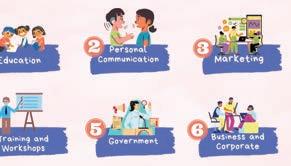
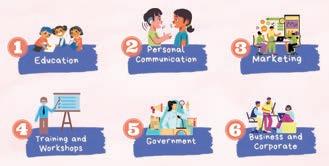

Where else can we use presentations?

Let us make a presentation on the topic ‘Solar System’. We will use Google Slides to make the presentation.
Google Slides is an online presentation tool that lets you create and share exciting projects.
Using Google Slides, you can easily add images, text, sound, and make your text move and change colours. You can even work online with friends. You don’t need to be on the same computer!
Whatever you do on Google Slides, is automatically saved.
The first satellite, Sputnik 1, was launched by the Soviet Union on October 4, 1957. Did You Know?

Google Slides have Noto support for many languages. Find out more about it here!
The main components of Google Slides are:
1. Rename box: Shows the name of the file that contains the presentation. By default, it is Untitled Presentation. You can rename it as per your choice.
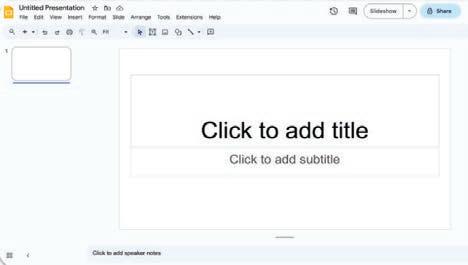
2. Menu bar: Holds various menus like ‘File’, ‘Edit’, ‘View’, etc. Each menu offers different options.
3. Toolbar: Holds tools for quick and easy access.
4. Slide workspace: The area in your slide where you add items such as text, images, and videos.
5. Slides panel: The space where you can see thumbnails of all the slides of your presentation.
6. Speaker notes: The area where you can add notes for yourself or the presenter. It helps us to remember important things during the presentation.
7. Slideshow button: Turns the slides into the presenter mode.
Before we start adding things to our presentation, let us learn how to name it. These are the steps:
1. Click on Rename box. Type the new name for your file.
2. Press the Enter key and the file will be automatically saved.


Now that we have named our file, let us add a title to our presentation. Follow the given steps:
1. Click on the Slide Workspace.
2. Type “Solar System”.

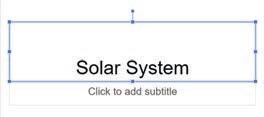
In case we want to add more text, we can add our own text boxes to add text on a slide.
Steps to add text with a Text box on a slide:
1. Click on the Insert tab.
2. Click on the Text box option from the drop-down menu.
3. Move the mouse cursor on the screen to the slide where you want to add the text box, then press the left button on the mouse.
4. Type “YOUR NAME”.

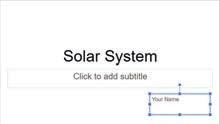
Now, let us learn to change the position of the text box after adding text in it.
Steps to move the text box on a slide:
1. Select the text box you want to move.
2. Once the four-headed arrow appears, press the left mouse button and hold it.
3. Move the mouse to drag the text box to where you want it to be.

We use presentations to:
a Share information interactively
c Include data and images
b Share information in an organized way
d All of these
What is the next step in creating a slide after you name it?
a Add Title
c Add Text box
b Go to Google Slides
d Click on the + Blank option
What can be used to add a main idea or topic to a slide in Google Slides?
a Notes
c Image
b Presentation Title
d Chart
What is the correct way to move a text box to a new position on a slide?
a Drag and drop the text box to the new location
c Select the text box and adjust the text
b Double click on the text box
d Remove the text box
Now that we have created our title, we need to have more slides to add the text of our project. Let us learn how to add more slides to our presentation.
Steps to add more slides:
1. Right-click in the Slides panel.
2. A menu will appear. Select the New slide option. A new slide will appear below your current slide.
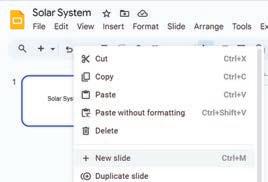
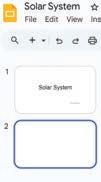
We have added a new slide. Now, let us learn to insert shapes on a slide to create our sun.
Steps to insert a shape on a slide:
1. Click on the Insert tab in the menu bar.
2. Select the Shape option from the drop-down menu. Then, select the Shapes option.
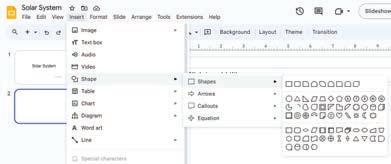
3. Click on the shape you want and write its name in the title. It will appear on your slide.
Steps to move a shape in presentation:
1. Select the shape you want to move and hold the left mouse button.
2. Drag and drop the shape to where you want it, on the slide. The shape will be at the new position. 3 1 2


After adding a shape on our slide, we can move it to a different place on the slide in the same way we moved our text box.

Let us learn to resize a shape to make our sun a little bigger.
Steps to resize a shape:
1. Select the shape, and a blue margin with dots will appear.
2. Move the mouse to drag it to make it larger or smaller.
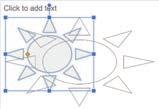
Let us learn to add colour to our shape.

Steps to add colour to a shape in presentation:
1. Select the shape that you want to colour.
2. Click on the Fill color tool on the toolbar and select the colour of sun. The image will look like as given.
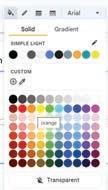

We can add and edit images in a presentation as we need to. Let us now add an image of the solar system on a new slide.
Steps to add an image in presentation:
1. Click on the Insert tab in the menu bar.
2. Go to Image menu in the Insert drop-down.

3. Select the Upload from computer option.
4. The Open dialog box appears. You can then select the image that you want to put on the slide.
Let us resize the image to fit it in the slide.
Steps to resize an image in the presentation:
1. Click the image to select it.
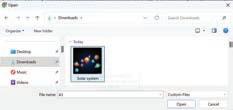
2. The blue squares at the corners of the image will appear.
3. Press the left mouse button on a blue square and drag it inwards to make it smaller.
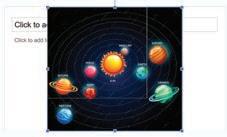

4. Similarly, you can enlarge the image by dragging it outwards.
Cropping an image means to remove any unwanted parts from it.
To crop an image, you can use the crop tool.
Steps to crop an image in the presentation:
1. Click on the image to select it.
2. Select the Crop tool that appears in the tools bar when the image is selected.
3. The black lines will appear on corners and edges.
4. Drag from black lines to crop the image.
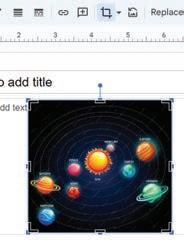
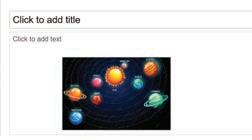
a Slide
Duplicating a slide means to create a copy of it.
Steps to duplicate slides in the presentation:
1. Select the slide you want to duplicate from the Slides Panel.
2. Right-click on the slide, and then select the Duplicate slide option.
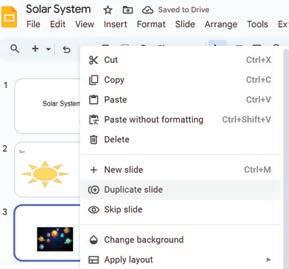
We can delete a slide if it is not needed anymore in the presentation.
Steps to delete slides:
1. Select the slide you want to delete.
2. Right-click on the slide.
3. Select the Delete option.
4. You can also delete a slide by selecting it and pressing the Delete key on the keyboard.
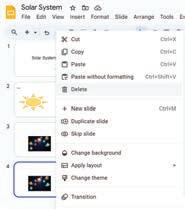
After completing your presentation, it is time to showcase your work to your teacher and classmates. Let us learn how to present a slide show.
Steps to show a presentation:
1. Click on the View tab.
2. Click on Slideshow.
OR
Click on the Slideshow button in the top right-hand corner of the menu bar.
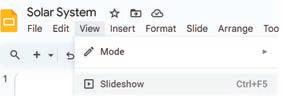
You already know that whatever you do on Google Slides, is automatically saved. So you can simply close it by clicking on the close (X) button.
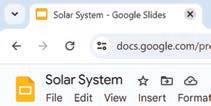
You may need to look at the presentation again. Let us learn how to re-open a file.
Steps to open a presentation:
1. Open Google Slides.
2. Click on the “Recent presentations” tab.
3. Select the file that you want to open.
4. The desired file will open.
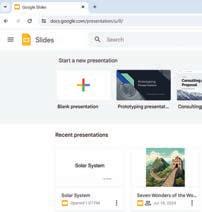
Do It Yourself 6B
Fill in the blanks.
1 We can insert an image into our slide by clicking on the tab in the menu bar.
2 an image means that we are making it smaller or larger.
3 If a part of the image is not needed, we can it.
4 If we need a new slide that is an exact copy of the previous slide, we can it.
5 A slide that is not needed can be
A is a tool to create, showcase and share information in an interactive way. We can an image around by dragging it on the workspace. is the component of Google Slides that holds tools for quick access.
B. Tick () the correct option.
What are presentations best used for?
a Playing games
c Solving maths problems easily
Which of the following is not a part of a presentation?
a Slides
c Videos
How do you add a new slide to your presentation?
a By clicking on the + button on toolbar
c By selecting a slide
b Sharing information with others
d Writing paragraphs
b Words
d Paint
b By clicking the “Add Slide” button
d By clicking on slideshow
What menu option allows you to add an image to your slide in Google Slides?
C. Who am I?
I help you create presentations online with images and words. You use me when you need to keep only a portion of an image.
With me you make your shapes and images smaller or bigger. You can use me to fill colours in the shapes. I only appear on the toolbar when a shape is selected.
D. Write T for True and F for False.
File, edit, insert, view, and arrange are known as Title bars.
Google Slides helps us to present projects.
In Google Slides you cannot add images.
You can open your existing file from the recent presentations.
E. Answer the following questions.
What do you do to add images to your Google Slides?
F. Apply your learning.
Shikha wants to add an image to the slide with the text. How can she do that?
Rahul wants to open slides again to add more shapes. How would he add shapes to his slide?
Mohan is confused between resizing and cropping. Help him understand these two tools.
Jyoti wants to change the colour of shapes on her Google Slides. How would she do that?

Let us make a paper whale using origami sheet by following a sequence of instructions.
Just like how we use instructions to do something step-by-step, we need to tell computers how to do something step-by-step too.
But computers do not understand our language. So, we need to use a special language that they can understand.
This language is called coding language.
Coding is a way of giving instructions to tell a computer what to do.
We will be using block-based coding to make computers do things for us.
Block-based coding is a computer language that uses colourful coding blocks to make computers do a task.
You must have played computer games, right?
But do you know you can use block-based coding to create games too?
We will use a block-based coding platform named Scratch 3.0 to create a game.
Scratch 3.0 is a free and simple platform where we use colourful blocks to create our own games, stories, and art.

Scratch got its name from how DJs mix music by scratching the music discs over one another. Did You Know?
Now, let us learn to create a blank project and name it ‘Saving Marine Life’.
Follow the given steps to create a project.
1 Click Create. The Scratch editor opens.

2 Change the name of the project from ‘Untitled’ to ‘Saving Marine Life’.
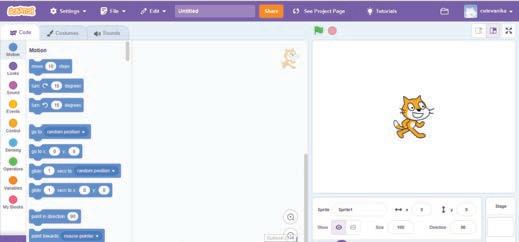
The Scratch editor holds all the components needed to create and run a Scratch project. The components of the Scratch editor are shown in the following picture:
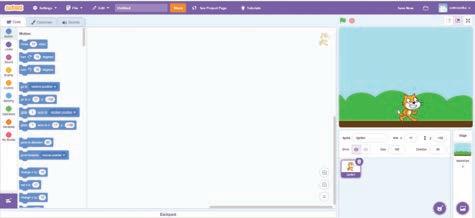
1 Menu bar: The purple bar at the top of the Scratch editor is called the Menu bar. The main parts of the Menu bar are:
a. File and Edit menus: These let us create, save, and open a project.
b. Project Name: This shows the name of your project. The default name of a Scratch project is ‘Untitled’.
c. Folder: Clicking here takes you to the ‘My Stuff’ page to see your saved projects.
2 Sprite: A sprite can be a character or an object in a Scratch project.
3 Tabs: There are three tabs in the Scratch editor:
a. Code: This tab has different code blocks and the coding area, also called the scripts area, where we can drag and join the blocks to make the sprite move and do things.
b. Costumes: This tab opens the Paint Editor window where we can change how a sprite looks.
c. Sounds: This tab opens the Sound editor to add and make changes to the sound effects of our sprite and to the backdrop.
4 Blocks Panel: The Blocks Panel has nine colour-coded block categories to help us create scripts. These are Motion, Looks, Sound, Events, Control, Sensing, Operators, Variables, and My Blocks.
5 Blocks Palette: The Blocks Palette is the area where we can see all the blocks for each block category.
6 Coding Area: The place where we can drag and join blocks from the Blocks palette to create a script is called Coding Area.
A Script is a set of blocks that are placed on top of each other to make a sprite do something.
7 Stage: The stage is where we can see backdrops and sprites in action.
8 Sprites Pane: The Sprites Pane is below the stage. It shows all the details of sprites, like their name, location, and size. You can use it to add, upload, edit, or delete sprites.
9 Backdrop: It is the background of the stage. You can add backdrops from the Scratch library or your computer.
10 Backdrops Pane: It is below the stage and next to the Sprites Pane. You can use it to add, upload, edit, or delete backdrops.
11 Go button and Stop button: The green flag is the Go button. You can click it to run the script. The red button is the Stop button. You can click it to stop the running script.
12 Add Extensions button: This button provides additional blocks that can be integrated into the Scratch editor’s blocks palette, expanding its functionality. These blocks help Scratch programs to interact with external hardware and online resources.
13 Sprites List: This list contains the thumbnails of all the sprites used in the project.
Identify and label the components.

c.
a I am a character in your project.
b I show you options to change the name, size, and location of a character.
c I hold colour-coded categories of blocks.
d I am the area where you drag and join the blocks.
e I hold all the blocks of a block category.
1 is a way of giving instructions to tell a computer what to do.
2 The is the area where we can see all the blocks of a block category.
3 The is where we can see backdrops and sprites in action.
4 The shows all the details of sprites, like their name, location, and size.
5 The button is used to stop the running script.
B Tick () the correct option.
1 Which of the following tabs does the Scratch editor contain?
a Code
c Sounds
b Costumes
d All of these
2 The Sounds tab is used to .
a to make changes to the sound
c close the Code tab
b listen to songs
d open the Costumes editor
3 Where do you drag and drop the blocks to create a script?
a Coding Area
c Blocks Palette
b Stage
d Sprites Pane
4 The is used to .

a stop the running script
c change the costume
b run the script
d move the sprite
5 Which of the following is the name of a block category?
a Motion
c Control
C Who am I?
b Sensing
d All of these
Component Purpose
Sprites Pane Holds nine categories of blocks
Backdrops Pane Shows backdrops and sprites in action
Blocks Panel Shows the details of sprites
Blocks Palette Adds backgrounds
Stage Holds all blocks of each block category
D Write T for True and F for False.
1 The default project name in Scratch is Project1.
2 You can add and make changes to the sound effects of the sprite and backdrop in the Sound Editor.
3 The green flag button is used to stop the running project.
4 Events is one of the categories of blocks.
5 The colour of the Go button is green.
E Answer the following questions.
1 What is block-based coding?
2 What is Scratch 3.0?
3 What is the role of the Code tab?
4 What does the Add Extension button help us with?

5 Describe the Go and Stop buttons.
F Apply your learning.
Tisha wants to learn coding, but she has not tried it before.
1 What coding language can she start learning? Why?
2 What should she add to her project to do the action?
3 What can she use to add more blocks?
4 How can she make her sprite look different?
5 What can she use to change the background of her project?
Suppose you are going to a jungle-themed party. You will need to wear a costume according to the character you are playing; it can be a person, plant, animal, or any other object.
In Scratch, a sprite is a character or an object on the stage.
Just like how you change your costume to play different characters, a sprite can also change its costume.
A costume is the appearance of a sprite.
You can change the sprite’s costume to make it look like it is moving, changing, or doing many things in your project.
Sprites Library
You can add sprites from the Sprites Library of Scratch or your computer.
You can also draw or edit your sprite as per your need.
A Sprites Library is a collection of ready-to-use sprite images.
Did You Know?
Red sprites are big red flashes of light that happen high in the sky during thunderstorms. They are so big that they can be seen from space.
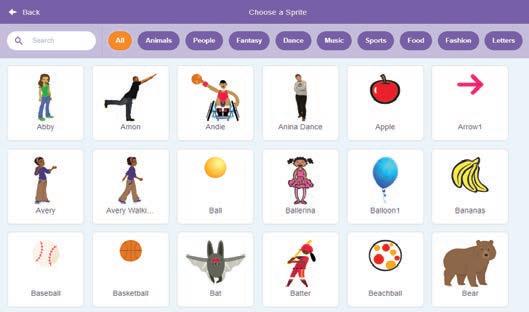

The idea of the ‘Saving Marine Life’ project is to make the crab (saviour) sprite catch the milk (trash) sprite to protect the underwater creatures. So, in this project, we need the following sprites:


To start the project, we need to add our sprites. As you know, the Cat sprite is the default sprite in Scratch. Before adding the sprites for our project, we need to remove the Cat sprite.
To delete the Cat sprite:
1 Select the thumbnail of the Cat sprite from the Sprite List.

2 The Delete button will appear.

3 Click the Delete button to delete the sprite.

In Scratch, we can add a sprite in four ways.
1 Choose a Sprite – To choose a sprite from the Sprites Library.
2 Paint – To create a sprite using Paint Editor.
3 Surprise – To add a random sprite.
4 Upload Sprite – To upload a sprite that is already saved on the computer.
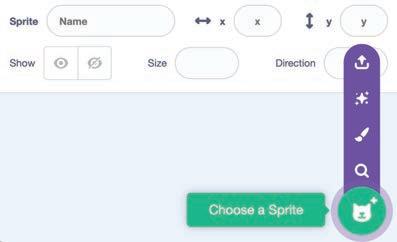



Now, let us add our first sprite, the Crab, from the Sprites Library into our project.
Steps to add a sprite from the Sprites Library:
1 Click the Choose a Sprite option in the Sprites Pane.
2 The Sprites Library will open.
3 Click the Crab sprite.



4 The sprite appears on the stage and its thumbnail is added to the Sprites List.
5 Change the Size of the Crab sprite to 40 from the Sprites Pane.

Similarly, add the Milk Sprite from Sprites Library and set its size to 30.
The Sprites Pane will look like this.
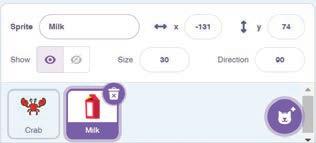
Let us rename the sprites for our project. Follow the given steps to rename a sprite:
1 Click on the sprite you want to rename in the Sprites Pane.
2 Click on the Sprite text box and delete the default name.
3 Type in the new name for your sprite. For this project, let us rename the Crab sprite as Saviour and the Milk sprite as Trash.
4 Press Enter or click outside the text box.
5 The new name will reflect in the Sprites Pane.
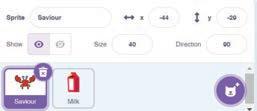
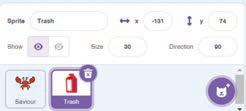
It is time to add a background to our project.
The way we add sprites in Scratch, we can also add backgrounds from the Backdrops Pane. There are four ways to add a backdrop.
1 Choose a Backdrop – To choose a backdrop from the Scratch Backdrops Pane.
2 Paint – To create a backdrop using Paint Editor.
3 Surprise – To add a random backdrop.
4 Upload Backdrop – To upload a backdrop from the computer.





Now, let us add the Underwater 1 backdrop to the Stage. Steps to add a backdrop to the project:
1 Click the Choose a Backdrop option in the Backdrops pane.
2 The Backdrops Library will open.

3 Search for the Underwater 1 backdrop by typing its name in the search bar.

4 Click the Underwater 1 backdrop. The backdrop appears on the stage and its thumbnail is added in Backdrops Pane.
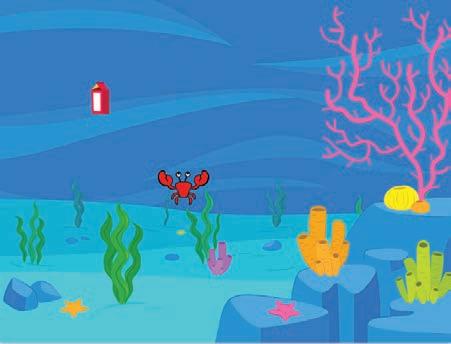
Let us create a sea bed in our backdrop using the Paint option.
1 Click on the thumbnail of the backdrop in the Backdrops Pane.
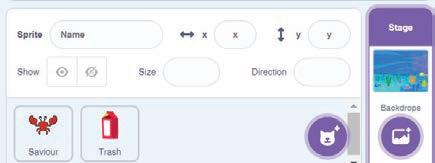
2 Click on the Backdrops tab on the left side of the screen. The paint editor for the backdrop will open.
3 Choose the colour of the sea bed using the Fill option.
4 Set the colour to 17, saturation to 56, and brightness to 58.
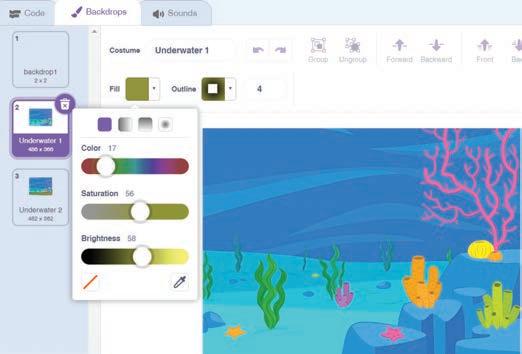
5 Select the Rectangle tool.
6 Draw a rectangle on the lower portion of the backdrop.

7 Click on the Outline option and pick the color picker tool.
8 Select the same colour from the rectangle and hover it over the outline to make the outline of the same colour.
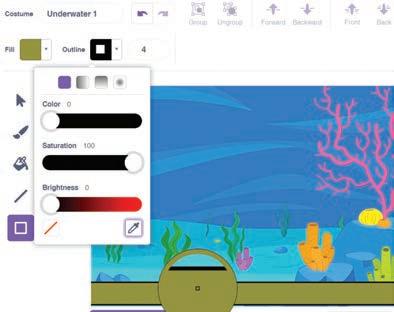
9 You will see the sea bed created on the backdrop.
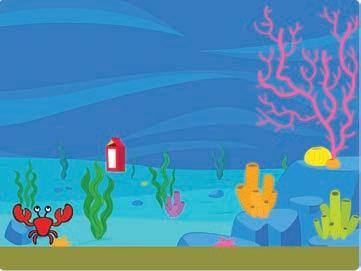
10 Finally, our stage is set for our project.
1 Tick () the food sprite from the following.




2 Search for the following backdrops in the Backdrops library and write their names.
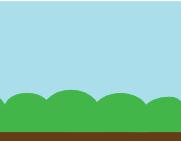
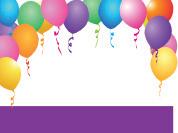
A Fill in the blanks.
1 is a character or an object who acts on the stage.
2 A is a collection of ready-to-use sprite images.
3 is the appearance of a sprite.
4 The option is used to add a backdrop from our own computer.
5 There are ways to add a backdrop.
B Tick () the correct option.
1 Which of the following options can let you add your own picture as a sprite?

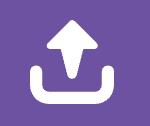


2 Which option is used to set the colour while using the Paint option.
3 Which option is used to make the sprite big or small?
4 Which of the following options is used to change the background of the stage?


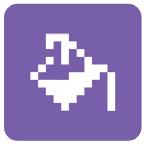


1 I can show different scenes, such as a forest, a city, a farm, or a school.
2 I can remove a sprite from a Scratch project.
3 I help you change the name of a sprite.
4 I am used to add a random sprite.
5 I can add a backdrop from your computer.
D Write T for True and F for False.
1 Sprites are characters or objects that can move, talk, and interact on the stage.
2 Upload Sprite option is used to upload a sprite that is already saved on the computer.
3 We can add only one sprite in the Scratch project.
4 Backdrops are the backgrounds used to set the stage for a project.
5 There is only one way to add a sprite.
E Answer the following questions.
1 Which component in a Scratch project can act? How can we add it to our project?
2 What is the role of Backdrops Pane in Scratch?
3 How can we delete a sprite?
8 • Sprites and Backdrops
4 How can we rename a sprite?
5 Write the ways to add a backdrop in a project.
F Apply your learning.

1 Ria wants to create and design her project to showcase the benefits of games in our life as shown.
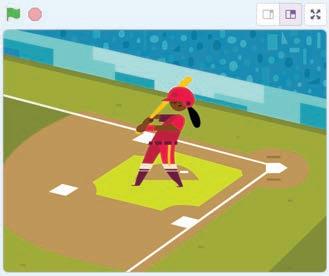
a What option can she use to delete the default sprite in her project?
b Which component of Scratch Editor can help her add a new backdrop to the stage?
2 Label the elements in the given picture.
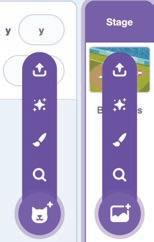
3 Arjun is creating a Scratch project in which he wants to remove some parts of the backdrop. Which option can he use to do this?
4 Ravi wants to add three new sprites to his Scratch project, which he has downloaded from the internet. Which option will help him complete the task?

Riya and Jay’s school has organised a summer carnival in the school. The school has sent the invitations to all the students.
Riya and Jay have decided to go to the carnival after receiving the invitation. Here, receiving the invitation is an event and going to the carnival is the action.
An event tells us when an action will happen. An action happens when an event occurs.
In Scratch, we have various Events blocks. They are yellow in colour.
They tell the computer when to run a script.
Some of the Events blocks are:
Blocks



Description
The Events blocks are also known as Hat Blocks.
Runs the attached script when the green flag is clicked.
Runs the attached script when the specified key is pressed.
Runs the attached script when the particular sprite is clicked.
In the previous chapter, we designed our Scratch project ‘Saving Marine Life’ by adding sprites and a backdrop.
Now, let us code the sprites to do some actions.
Before we start, do you remember the idea of the project?
The idea is to make the saviour sprite catch the trash sprite to protect the underwater creatures, remember?
Now, we need to break the idea into smaller tasks.
Let us divide the whole project into five subtasks:
1 Show a message from the saviour to catch the trash.
2 The saviour should be able to move left and right using the left and right arrow keys.
3 The trash should appear randomly and start falling.
4 If the falling trash touches the saviour, the trash should disappear.
5 If the falling trash touches the sea bed, the trash should display a message.
Let us start coding the saviour sprite.

We will use the Say block to make the sprite talk. The Say block is found in the Looks category of blocks.
Looks blocks are used to control how a sprite looks. They are purple in colour.
Blocks

Description
Using this block, a speech bubble appears over the sprite and stays for the specified number of seconds.
Steps to make a sprite say something:
1 Select the Saviour sprite.
2 Drag and drop the when green flag clicked block from the Events category in the Scripts Area.
3 Drag the say Hello! for 2 seconds block from the Looks category and join it to the when green flag clicked block.
4 Change ‘Hello!’ with ‘Help me catch the trash.’

5 Click the Go button to check if the Saviour says the specified message.

Now, you must have observed that the saviour is showing the message at a random position. Let us move the sprite at a specified position with the help of Motion blocks.
Motion blocks are used to control the movement of the sprites. They are blue in colour. There are various Motion blocks. Some of them are:
Blocks




Description
Moves the sprite to the specified x and y positions.
Changes the x position of a sprite by a specified value. Moves the sprite forward or backward with positive or negative values, respectively.
Changes the y position of a sprite by a specified value. Moves the sprite upwards or downwards with positive or negative values, respectively.
Moves the sprite to any random position.



If touching the edge of the screen, the sprite bounces back.
Sets the rotation style of a sprite.
Set the direction of the current sprite.
X-Axis Y-Axis
A sprite’s X Position is its location on the X (horizontal) axis of the stage.

The Y Position is where the sprite is on the Y (vertical) axis of the stage.
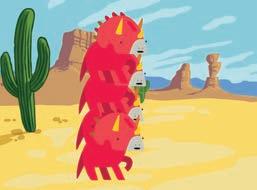
Follow the steps to move the sprite to the specified position:
1 Drag and drop the go to x: () y: () block from the Motion category in the Scripts Area.
2 Change the value of x to –182 and y to –136.
3 Join it below the when green flag clicked block.
4 Then, attach the say () for () seconds block to the go to x: () y: () block.
5 Click the Go button to check if the Saviour says the message at a specified position.
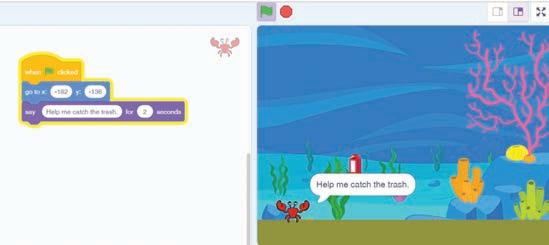
1 Match the following blocks with their description.
Column A




2 Guess the correct block category.
a I am yellow in colour.
b I am purple in colour.
c I am blue in colour.
Column B
Sets the direction of the current sprite.
Makes the sprite say Hello for 2 seconds.
Runs the attached script when the green flag is clicked.
Moves the sprite to any random position.
Imagine your community is having a tree planting event, and you are going to join in with your parents.
Suppose you have to plant 10 saplings. How will you do that? You will be planting saplings, one after another. This repeating action is called a loop.
A loop means doing something over and over again.
In Scratch, we have repeat and forever control blocks that are used to repeat actions. In coding, we use loops to save time to build our scripts quickly.

The Control blocks are used to control the flow of scripts based on some criteria. They are orange in colour. Some of the Control blocks are:
Blocks




Description
A loop that repeats actions for the specified number of times. Runs the given set of blocks forever until the Stop button is pressed.
Pauses the script for specified seconds.
Checks the condition and if the condition is true, the blocks inside it will be activated.
How do you react when you touch a hot object? You immediately remove your hand, right? This means you react when you sense something. Similarly, we can make sprites sense each other when they touch.
In Scratch, we have Sensing blocks to do this. Sensing blocks are used to detect when two characters touch each other.
They are used to detect other sprites, colours on stage, keypress, mouse click, and user input.
There are 18 Sensing blocks. They are light blue in colour.
Some of the Sensing blocks are:



Steps to move the Saviour sprite:
Activates the blocks below it when a sprite touches the specified object.
Activates the blocks below it when a sprite touches the specified colour.
Activates the blocks below it when the specified key is pressed.
1 Select the Saviour sprite in the Sprites List.
2 Go to the Control block category.
3 Drag and join the forever block below the say block.
4 Drag and join the if… then block from the Control category inside the forever block.
5 Drag the key space pressed block from the Sensing category to the blank section of the if… then block.
6 Click the drop-down button in the key space pressed block and change space to right arrow.
7 Drag and join the point in direction block inside the if… then block.
8 Drag and join the change x by block under the point in direction block inside the if... then block.
9 Change the value of x to 10.
10 Click the Go button to test if the sprite moves in the right direction.

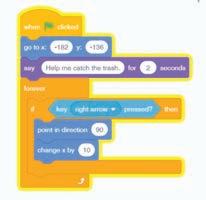
Similarly, create the code to move the sprite in the left direction by changing the value of the key space pressed block to the left arrow and changing the value of x to -10.
The code will look like this:
Now, we have done the coding of the Saviour sprite. Let us now start coding the Trash sprite.
Steps to make the Trash sprite fall:
1 Select the Trash sprite in the Sprites List.

2 Drag and drop the when green flag clicked block from the Events category in the Scripts Area.
3 Drag and drop the go to x: () y: () block from the Motion category in the Scripts Area.
4 Change the value of x to 9 and y to 155. Join it below the when green flag clicked block.
5 Drag and join the forever block to the go to to x: () y: () block.
6 Go to the Motion block category.
7 Drag and join the change y by block inside the forever block.
8 Change the value of y by -10.
9 Go to the Control block category.
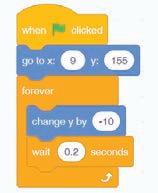
10 Drag and join the wait () seconds block under the change y by -10 block inside the forever block.
11 Change the seconds to 0.2.
12 Click the Go button to test if the sprite appears at a random position and falls forever.
The project will look like this.
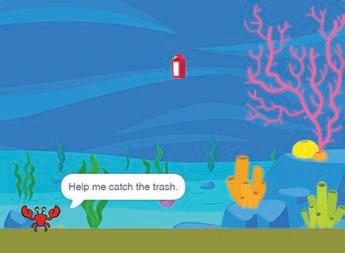
1 Select the correct code to make the sprite go to random position. Do It Yourself 9B
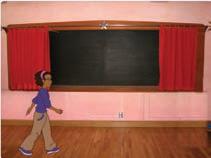




A Fill in the blanks.
1 The block moves the sprite to any random position.
2 A means doing something over and over again.
3 To create repeating actions, you can use the block in a script.
4 The Motion blocks in Scratch are in colour and are used to add motion to a sprite.
5 An tells you when the action will happen.
B Tick () the correct option.
1 Which of the following blocks is used to run the script when the up arrow key is pressed?




2 Which is the correct script to make a sprite fall forever?
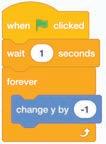

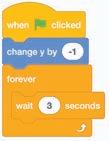

3 Which of the following blocks move a sprite upwards?




4 Which of the following blocks is used to run the script until the Stop button is pressed?



d All of these
5 blocks are purple in colour.
a Motion
c Looks
C Who am I?
Who Am I ?



D Write T for True and F for False.
1 Kicking a football is an event.
b Sensing
d Control
What I Do?
Moves the sprite forward or backward with a positive or negative value, respectively.
Moves the sprite upwards or downwards with a positive or negative value, respectively.
Pauses the script for specified seconds.
2 The Say block is used to make the sprite talk in Scratch.
3 Repeating action in coding means doing something only once.
4 Motion blocks are used to control the movement of the sprites.

5 The block in Scratch runs a script when the green flag is clicked.
E Answer the following questions.
1 How is the repeat block helpful?
2 If you use these blocks, how will they change the position of the sprite?



3 What are Events blocks?
4 What will happen to the sprite if we run this code?
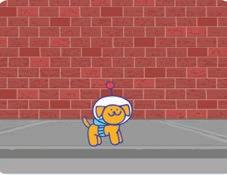

5 Differentiate between the repeat and forever blocks.
F Apply your learning.
1 Look at the blocks given below and number them from 1 to 4 in order to make the sprite fall when the Go button is pressed.




2 What will be the output of the following script?

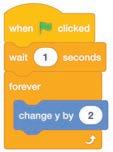
3 Write the script to display this message.
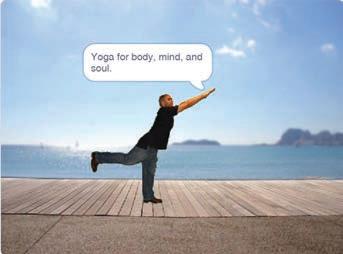
4 Along which axis is the Penguin sprite moving? Can you explain the reason?

Events and Loops
A. Fill in the blanks.
1 Things around us that perform specific tasks are called . 2 is a type of operating system.
3 A folder within a folder is called a .
4 A website is a collection of that are all related to each other.
B. Tick () the correct option.
1 1024 MB is equal to .
a 1 KB
c 1 GB
b 1 MB
d 1 TB
2 The is a type of communication media that uses your telephone line to transmit data.
a DSL
c Fibre
b Cable
d None of these
3 a file means removing it from your computer.
a Deleting b Renaming
c Restoring
C. Write T for True and F for False.
d Duplicating
1 RAM stores information about the programs you are using right now.
2 The OS helps you to organise files and folders in a proper way.
3 Creating a folder means changing the name of the digital folders.
4 Google Chrome is a web browser made by Microsoft.
D. Answer the following questions.
1 What is cloud storage?
2 What is operating system?
3 What does restoring a file or folder mean?
4 What are search engines? Give examples.
E. Apply your learning.
1 Kiara wants to change the position of the taskbar on her screen. How can she move the taskbar to the right of the screen?
2 Nikhil wants to create a new folder on the desktop to keep his personal documents. What are the steps to create a new folder?
3 Jatin is confused about the difference between a web browser and a website. Can you clear his confusion by explaining the difference?
Test Paper 2 (Based on Chapters 5 to 9)
A. Fill in the blanks.
1 The button is used to run the script in Scratch.
2 is used to add a random backdrop.
3 An event tells us when an will happen.
4 tool makes the selected parts of the text look thinner and leaning towards the right side.
B. Tick () the correct option.
1 a slide means creating an exact copy of an existing slide in your presentation.
a Deleting
c Presenting
b Duplicating
d Closing
2 Where do you drag and drop the blocks to create a script?
a Coding Area
c Blocks Palette
b Stage
d Sprites Pane
3 blocks are used to control the movement of the sprites.
a Looks
c Motion
b Sensing
d Events
4 tab opens the Paint Editor window where we can change how a sprite looks.
a Code
c Sound
C. Write T for True and F for False.
b Costume
d All of these
1 Line breaks can start a new line without creating a new paragraph by pressing Enter.
2 Slides panel is the space where you can see thumbnails of all the slides of your presentation.
3 The default project name in Scratch is Untitled.
D. Answer the following questions.
1 What is a Sprites Pane?
2 What is the use of control blocks?
3 What do you mean by formatting a text?
4 Write the steps for naming a presentation.
E. Apply your learning.
1 Write the script to display the message ‘Health is wealth!’
2 Observe the script and write down the output. Are you hungry? Eat an apple.

3 Atishay wants to type the chemical formula for carbon dioxide (CO2) in his document. What formatting option should he use for the number “2” to display it as shown?
Artificial intelligence has become an important part of our lives. We use AI in many devices around us. These devices are connected with the help of IoT.
The Internet of Things (IoT) is a system where everyday objects, such as TVs, air conditioners, remotes, and doorbells, are connected to the internet and share data with each other.




Smartphones use AI for various tasks, such as face recognition, voice assistants, navigation, weather status, photo filtering, games, etc.
A smart speaker is a device that listens to our voice commands to play music, answer questions, and make phone calls.





Smartwatches are wearable devices that can track your fitness, monitor your health, show notifications from your smartphone, and even run apps.





























Smart TV allows its users to play music, films, or change channels using the internet. You can control a smart TV with your voice.
A smart doorbell notifies home owners on their mobile phones when someone arrives at the door and shows them who is there.
A smart refrigerator can monitor and manage its contents, suggest recipes based on what is inside, and notify you when you are running low on certain items.

A self-driving car uses AI to travel between destinations without human help. It has sensors and cameras that enable it to drive independently.
















































A smart home uses technology to automate and control various aspects of a household. This includes devices and systems like smart lights, security cameras, smart TVs, smart refrigerators, and voice assistants, all connected to the internet.
Uolo has introduced a comprehensive program, Hexa, for grades 1 to 8, to empower young minds with the knowledge and the skills they need to thrive in the digital age. From the basics of how computers function to the tools that shape our digital landscape, this series opens the door to a world of endless possibilities. This series will build a strong foundation, helping shape the next generation of digital citizens and innovators. It aims to demystify the world of computer science, making it accessible and engaging for young learners, while preparing them for future academic and professional pursuits in the field.
• AI Annexures: To offer a basic understanding of specific domains of Artificial Intelligence.
• Discuss: A multi-faceted probing question, related to the concept, that arouses curiosity.
• Think and Tell: Analysis, reflection, and text-to-self connection based prompts for discussion in class.
• Did You Know? Interesting facts related to the application of a concept.
• Do It Yourself: Short exercises between the chapter to pause and assess comprehension.
• Chapter Checkup: Chapter-end practice exercises aligned to different levels of Bloom's Taxonomy.
Uolo partners with K-12 schools to bring technology-based learning programs. We believe pedagogy and technology must come together to deliver scalable learning experiences that generate measurable outcomes. Uolo is trusted by over 15,000+ schools across India, South East Asia, and the Middle East.
ISBN 978-81-979297-1-7
